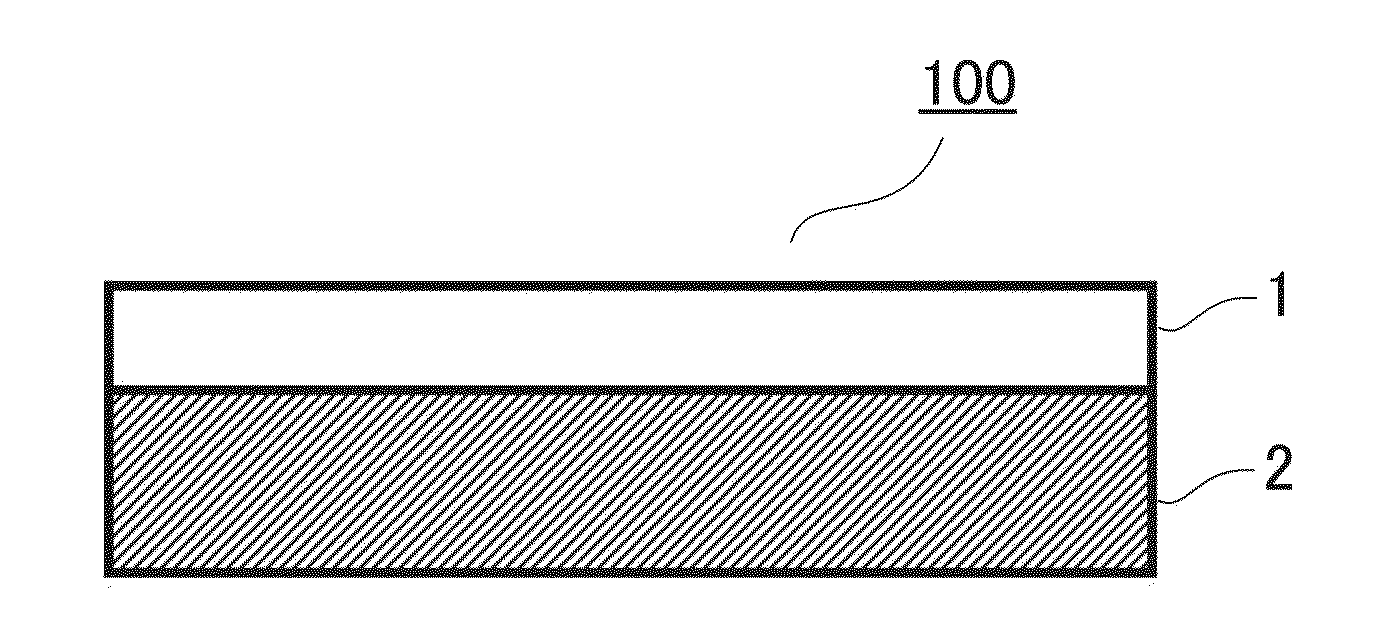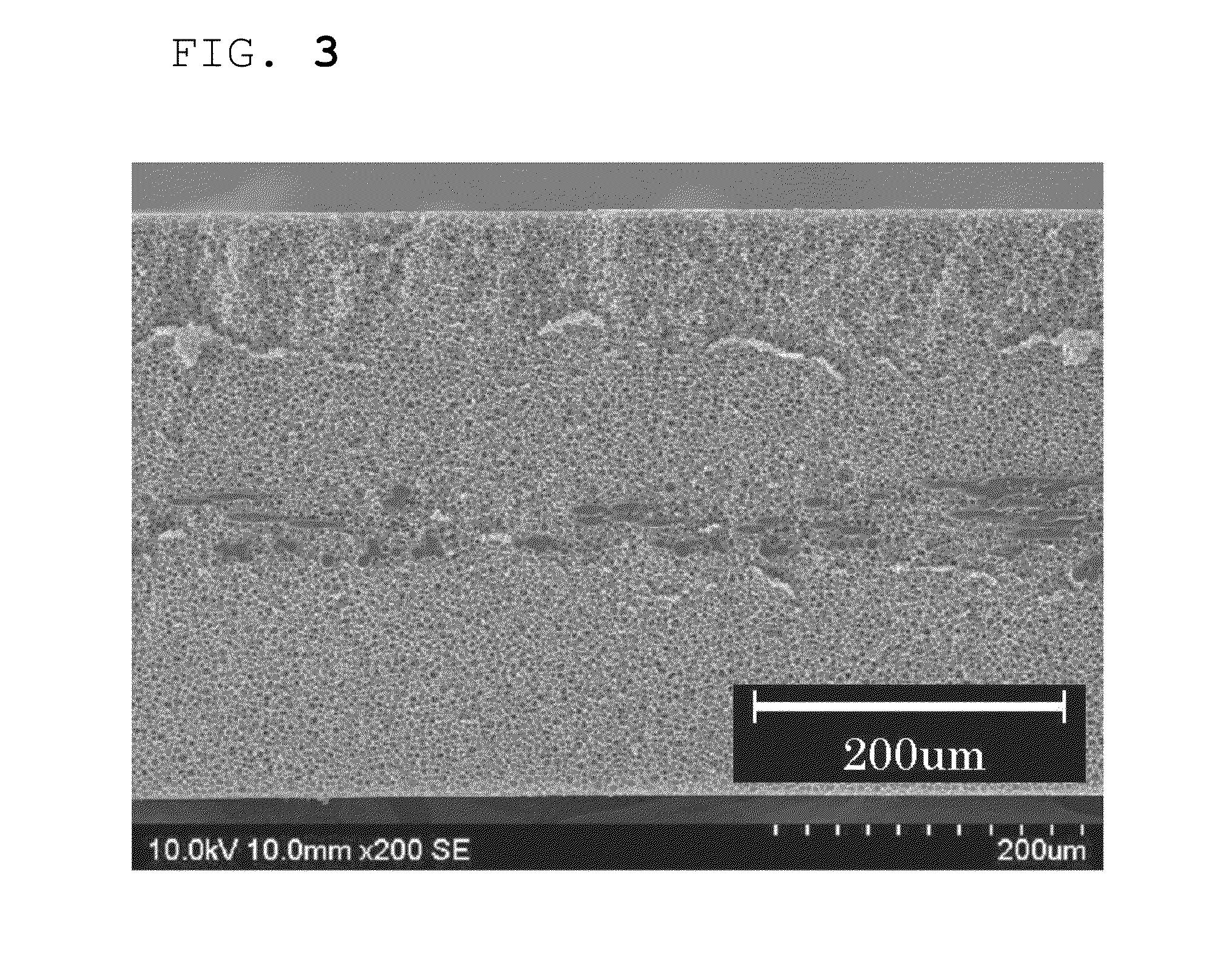Composite sheet
a technology of composite sheets and pore diameters, applied in the field of composite sheets, can solve the problems of difficult control of pore diameter size, difficult to perform wet type coagulation, and insufficient mechanical strength of composite sheets, and achieve excellent heat resistance, excellent mechanical physical properties, and low cost
- Summary
- Abstract
- Description
- Claims
- Application Information
AI Technical Summary
Benefits of technology
Problems solved by technology
Method used
Image
Examples
examples
[0185]Hereinafter, the present invention is described by way of examples. However, the present invention is not limited by these examples. It should be noted that normal temperature means 23° C.
[0186](Measurement of Molecular Weight)
[0187]A weight average molecular weight was determined by gel permeation chromatography (GPC).
[0188]Apparatus: “HLC-8020” manufactured by Tosoh Corporation
[0189]Column: “TSKgel GMHHR-H(20)” manufactured by Tosoh Corporation
[0190]Solvent: Tetrahydrofuran
[0191]Standard substance: Polystyrene
[0192](Static Storage Stability of Emulsion)
[0193]About 30 g of a prepared W / O type emulsion were weighed in a container having a volume of 50 ml. The emulsion was observed for its generation status of free water from immediately after the preparation, and evaluated for its static storage stability at normal temperature.
[0194]◯: No free water was generated even after 24 hours
[0195]Δ: A slight amount of free water was generated until 1 hour
[0196]x: Free water was generat...
production example a-1
Preparation of Mixed Syrup A-1
[0215]A reactor equipped with a cooling tube, a temperature gauge, and a stirrer was fed with 173.2 parts by weight of a monomer solution formed of 2-ethylhexyl acrylate (manufactured by TOAGOSEI CO., LTD., hereinafter, abbreviated as “2EHA”) as an ethylenically unsaturated monomer, 100 parts by weight of ADEKA (trademark) Pluronic L-62 (molecular weight: 2,500, manufactured by ADEKA CORPORATION, polyether polyol) as polyoxyethylene polyoxypropylene glycol, and 0.014 part by weight of dibutyltin dilaurate (manufactured by KISHIDA CHEMICAL Co., Ltd., hereinafter, abbreviated as “DBTL”) as a urethane reaction catalyst. To the stirred mixture were added dropwise 12.4 parts by weight of hydrogenated xylylene diisocyanate (manufactured by Takeda Pharmaceutical Co., Ltd., TAKENATE 600, hereinafter, abbreviated as “HXDI”), and the resultant mixture was subjected to a reaction at 65° C. for 4 hours. It should be noted that the usage of a polyisocyanate componen...
production example a-2
Preparation of Mixed Syrup A-2
[0216]A four-necked flask was fed with a solution obtained by adding 0.05 part by weight of 2,2-dimethoxy-1,2-diphenylethan-1-one (a product available under the trade name “IRGACURE-651” from Ciba Japan) and 0.05 part by weight of 1-hydroxycyclohexyl-phenyl-ketone (a product available under the trade name “IRGACURE-184” from Ciba Japan) to 100 parts by weight of a mixed monomer solution formed of 90 parts by weight of 2EHA as an ethylenically unsaturated monomer and 10 parts by weight of AA as a polar monomer. Under a nitrogen atmosphere and under a normal temperature atmosphere, the inner bath temperature was adjusted to 80° C. with a mantle heater, and the monomers were partially photopolymerized by exposure to UV light. Thus, a mixed syrup A-2 was obtained. The polymer generated by the partial polymerization had a weight average molecular weight of 1,070,000. Further, the mixed syrup A-2 had a polymer concentration of 25 wt %.
PUM
| Property | Measurement | Unit |
|---|---|---|
| Temperature | aaaaa | aaaaa |
| Length | aaaaa | aaaaa |
| Fraction | aaaaa | aaaaa |
Abstract
Description
Claims
Application Information
 Login to View More
Login to View More - R&D
- Intellectual Property
- Life Sciences
- Materials
- Tech Scout
- Unparalleled Data Quality
- Higher Quality Content
- 60% Fewer Hallucinations
Browse by: Latest US Patents, China's latest patents, Technical Efficacy Thesaurus, Application Domain, Technology Topic, Popular Technical Reports.
© 2025 PatSnap. All rights reserved.Legal|Privacy policy|Modern Slavery Act Transparency Statement|Sitemap|About US| Contact US: help@patsnap.com



